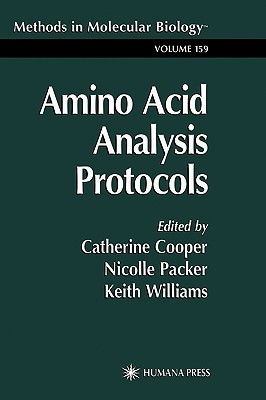
- We will send in 10–14 business days.
- Publisher: Humana
- ISBN-10: 0896036561
- ISBN-13: 9780896036567
- Format: 16 x 23.7 x 2.4 cm, hardcover
- Language: English
- SAVE -10% with code: EXTRA
Amino Acid Analysis Protocols (e-book) (used book) | bookbook.eu
Reviews
Description
Amino acid analysis is a technique that has become commonplace in biotechnology, biomedical, and food analysis laboratories. This book describes a variety of amino acid analysis techniques and how each technique can be used to answer specific biological questions. The first two chapters in Amino Acid Analysis Protocols introduce the concepts, basic theory, and practice of amino acid analysis. The following chapters give detailed instructions on various methods and their applications. As highlighted, there are many different approaches to amino acid ana- sis, but in all cases the results depend heavily on the quality of the sample. Therefore a new way to desalt samples prior to hydrolysis is covered as an introductory chapter (Chapter 3), and most authors have devoted a section to sample preparation, especially to the collection and storage of bodily fluids. Some of the amino acid analysis methods described in this book are based on HPLC separation and analysis after precolumn derivatization. The precolumn derivatization techniques described use (a) 6-aminoquinolyl-N-hydro- succinimidyl carbamate (AQC) (Chapters 4 and 8); (b) 1-fluoro-2- dinitrophenyl-5-L-alanine amide (Marfey's reagent), which allows sepa- tion and analysis of enantiomeric amino acids (Chapter 5); (c) O-phthalal- hyde (OPA) (Chapters 6 and 10); (d) butylisothiocyanate (BITC) and benzylisothiocyante (BZITC) (Chapter 11); (e) phenylisothiocyanate (PITC) (Chapters 12 and 13); (f) ammonium-7-fluorobenzo-2-oxa-1,3-diazole-4-s- fonate (SBD-F) (Chapter 17); and (g) 9-fluorenylmethyl-chloroformate (FMOC-Cl) (Chapter 10).
EXTRA 10 % discount with code: EXTRA
The promotion ends in 19d.20:01:48
The discount code is valid when purchasing from 10 €. Discounts do not stack.
- Publisher: Humana
- ISBN-10: 0896036561
- ISBN-13: 9780896036567
- Format: 16 x 23.7 x 2.4 cm, hardcover
- Language: English English
Amino acid analysis is a technique that has become commonplace in biotechnology, biomedical, and food analysis laboratories. This book describes a variety of amino acid analysis techniques and how each technique can be used to answer specific biological questions. The first two chapters in Amino Acid Analysis Protocols introduce the concepts, basic theory, and practice of amino acid analysis. The following chapters give detailed instructions on various methods and their applications. As highlighted, there are many different approaches to amino acid ana- sis, but in all cases the results depend heavily on the quality of the sample. Therefore a new way to desalt samples prior to hydrolysis is covered as an introductory chapter (Chapter 3), and most authors have devoted a section to sample preparation, especially to the collection and storage of bodily fluids. Some of the amino acid analysis methods described in this book are based on HPLC separation and analysis after precolumn derivatization. The precolumn derivatization techniques described use (a) 6-aminoquinolyl-N-hydro- succinimidyl carbamate (AQC) (Chapters 4 and 8); (b) 1-fluoro-2- dinitrophenyl-5-L-alanine amide (Marfey's reagent), which allows sepa- tion and analysis of enantiomeric amino acids (Chapter 5); (c) O-phthalal- hyde (OPA) (Chapters 6 and 10); (d) butylisothiocyanate (BITC) and benzylisothiocyante (BZITC) (Chapter 11); (e) phenylisothiocyanate (PITC) (Chapters 12 and 13); (f) ammonium-7-fluorobenzo-2-oxa-1,3-diazole-4-s- fonate (SBD-F) (Chapter 17); and (g) 9-fluorenylmethyl-chloroformate (FMOC-Cl) (Chapter 10).


Reviews